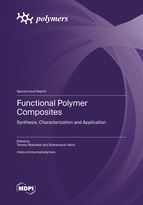Functional Polymer Composites: Synthesis, Characterization and Application
A special issue of Polymers (ISSN 2073-4360). This special issue belongs to the section "Smart and Functional Polymers".
Deadline for manuscript submissions: closed (20 August 2023) | Viewed by 22061
Special Issue Editors
Interests: smart materials; functionalization; antibacterial properties; surface analyses; electrospinning; biopolymers
Special Issues, Collections and Topics in MDPI journals
Interests: polymer crystallization; polymer blends and composites; bio-nanocomposites; sustainable materials science; nanofillers
Special Issues, Collections and Topics in MDPI journals
Special Issue Information
Dear Colleagues,
At present, functional polymer composites are increasingly promising materials in materials science and engineering. Polymer composites, including nanocomposites, are made by the incorporation of fillers in polymer matrices, and offer many advantages. The properties of polymer composites are further improved by the surface modification of fillers or the matrix phase. Currently, there is an increasing demand for smart materials based on eco-friendly polymers for a wide variety of applications. Therefore, functional polymer composites are essential to the development of new technologies.
This Special Issue, “Functional Polymeric Composites: Synthesis, Characterization and Application”, will be focused on the innovative original research and reviews in the field of functional polymer composites. Examples of acceptable research topics include: (a) surface modification, (b) smart biomaterials, (c) hybrid composites, (d) mechanical properties, (e) carbon, (f) textile materials, and (g) other functional polymer composites.
Prof. Dr. Tomasz Makowski
Dr. Sivanjineyulu Veluri
Guest Editors
Manuscript Submission Information
Manuscripts should be submitted online at www.mdpi.com by registering and logging in to this website. Once you are registered, click here to go to the submission form. Manuscripts can be submitted until the deadline. All submissions that pass pre-check are peer-reviewed. Accepted papers will be published continuously in the journal (as soon as accepted) and will be listed together on the special issue website. Research articles, review articles as well as short communications are invited. For planned papers, a title and short abstract (about 100 words) can be sent to the Editorial Office for announcement on this website.
Submitted manuscripts should not have been published previously, nor be under consideration for publication elsewhere (except conference proceedings papers). All manuscripts are thoroughly refereed through a single-blind peer-review process. A guide for authors and other relevant information for submission of manuscripts is available on the Instructions for Authors page. Polymers is an international peer-reviewed open access semimonthly journal published by MDPI.
Please visit the Instructions for Authors page before submitting a manuscript. The Article Processing Charge (APC) for publication in this open access journal is 2700 CHF (Swiss Francs). Submitted papers should be well formatted and use good English. Authors may use MDPI's English editing service prior to publication or during author revisions.
Keywords
- nanocomposites
- hybrid composites
- mechanical properties
- surface modification
- smart-textile materials







